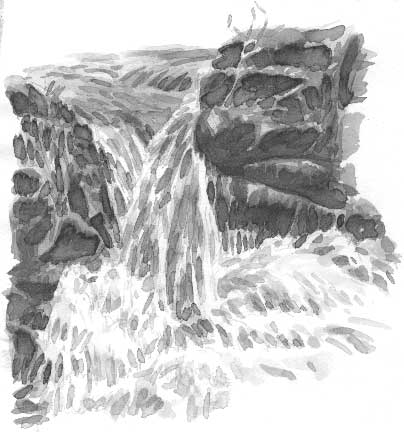|  After
yesterday's experiment with a still life, I'm trying out my ink wash technique
on a more challenging subject: a cataract just below Ladybower
reservoir, where the River Derwent tumbles over
an outcrop of sandstone. If I had so much difficulty with boxes, bottles
and tubes, just imagine what this will be like to draw! After
yesterday's experiment with a still life, I'm trying out my ink wash technique
on a more challenging subject: a cataract just below Ladybower
reservoir, where the River Derwent tumbles over
an outcrop of sandstone. If I had so much difficulty with boxes, bottles
and tubes, just imagine what this will be like to draw!
Irresistible Force, Immovable Object
I like the expression of energy in the rushing water and the way that
contrasts with the sombre solidity of the rocks. And it's all
organic; it's great to have an excuse to look closely at something so
natural for a few hours and to be surrounded by the damp, mossy woodland
atmosphere of the rocky riverside setting (despite the forecast, I didn't
need to open my fishing umbrella to day) and the white noise; the spattering
and rushing and the deep undercurrent, like a drum roll or an avalanche
about to start.
I wouldn't get that if I was interpreting this same scene from a photograph.
I like the experience of drinking in a dose of wilderness.
Pencil
Using the F grade pencil, I start with a quick outline but with just
a touch of shading to indicate some of the shadow areas, so that the maze
of lines and similar shapes isn't too confusing when I come to add the
washes.

Ink Wash
There are highlights all over the place; on the river and on the rocks,
but they're not all pure white: when I half close my eyes, I
can see that the lightest area is the frothy water at the foot of the
fall, so that will be represented by the white of the page. I paint a
wash of the palest shade of the diluted Chinese ink that
I'm using across the entire drawing except for the froth.
Later; after a break for a flask of Chai . . .
When the first wash dries I go over the drawing again with the same pale
tone to indicate darker areas like the river water above and the peaty
depths of the water tumbling over the fall.
Deep Shadow
I resort to a darker tone for the rocks but, several washes later, by
lunchtime, when I'm trying to finish the drawing, I'm aware that the shadowed
crevices of the rocks are much darker than I've painted them and, impatiently,
I try to put an even darker mixture of ink into those areas. You can see
that, particularly on the rock at the foot of the fall on the left of
the picture, this darker ink has run into the previous wash, which was
still damp, leaving a dark 'tidemark' around the edges. It reminds me
of a photographic technique called solarization.
Working in Washes
I found myself growing impatient as I waited for some of the later washes
to dry so in the afternoon I drew three smaller drawings of the other
falls in this cataract and worked on them in rotation.
These have been drawn for my Peak District sketchbook, so if you'd like
to see how I got on with them, don't forget to look out for my book when
it's published, hopefully some time this summer. 
Richard Bell, richard@willowisland.co.uk
|